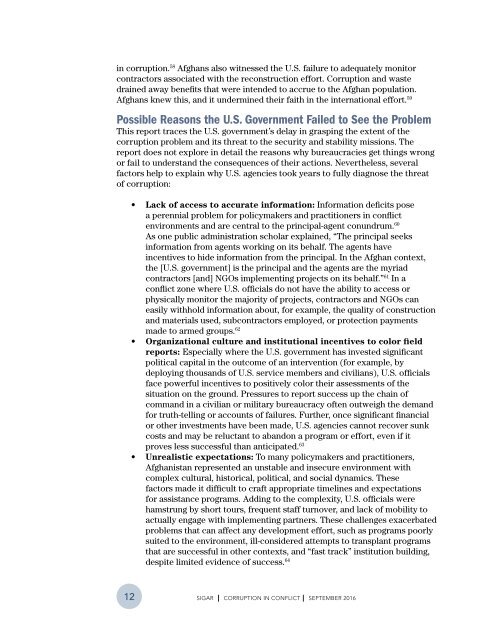CORRUPTION IN CONFLICT
5IlaWjQej
5IlaWjQej
You also want an ePaper? Increase the reach of your titles
YUMPU automatically turns print PDFs into web optimized ePapers that Google loves.
in corruption. 58 Afghans also witnessed the U.S. failure to adequately monitor<br />
contractors associated with the reconstruction effort. Corruption and waste<br />
drained away benefits that were intended to accrue to the Afghan population.<br />
Afghans knew this, and it undermined their faith in the international effort. 59<br />
Possible Reasons the U.S. Government Failed to See the Problem<br />
This report traces the U.S. government’s delay in grasping the extent of the<br />
corruption problem and its threat to the security and stability missions. The<br />
report does not explore in detail the reasons why bureaucracies get things wrong<br />
or fail to understand the consequences of their actions. Nevertheless, several<br />
factors help to explain why U.S. agencies took years to fully diagnose the threat<br />
of corruption:<br />
• Lack of access to accurate information: Information deficits pose<br />
a perennial problem for policymakers and practitioners in conflict<br />
environments and are central to the principal-agent conundrum. 60<br />
As one public administration scholar explained, “The principal seeks<br />
information from agents working on its behalf. The agents have<br />
incentives to hide information from the principal. In the Afghan context,<br />
the [U.S. government] is the principal and the agents are the myriad<br />
contractors [and] NGOs implementing projects on its behalf.” 61 In a<br />
conflict zone where U.S. officials do not have the ability to access or<br />
physically monitor the majority of projects, contractors and NGOs can<br />
easily withhold information about, for example, the quality of construction<br />
and materials used, subcontractors employed, or protection payments<br />
made to armed groups. 62<br />
• Organizational culture and institutional incentives to color field<br />
reports: Especially where the U.S. government has invested significant<br />
political capital in the outcome of an intervention (for example, by<br />
deploying thousands of U.S. service members and civilians), U.S. officials<br />
face powerful incentives to positively color their assessments of the<br />
situation on the ground. Pressures to report success up the chain of<br />
command in a civilian or military bureaucracy often outweigh the demand<br />
for truth-telling or accounts of failures. Further, once significant financial<br />
or other investments have been made, U.S. agencies cannot recover sunk<br />
costs and may be reluctant to abandon a program or effort, even if it<br />
proves less successful than anticipated. 63<br />
• Unrealistic expectations: To many policymakers and practitioners,<br />
Afghanistan represented an unstable and insecure environment with<br />
complex cultural, historical, political, and social dynamics. These<br />
factors made it difficult to craft appropriate timelines and expectations<br />
for assistance programs. Adding to the complexity, U.S. officials were<br />
hamstrung by short tours, frequent staff turnover, and lack of mobility to<br />
actually engage with implementing partners. These challenges exacerbated<br />
problems that can affect any development effort, such as programs poorly<br />
suited to the environment, ill-considered attempts to transplant programs<br />
that are successful in other contexts, and “fast track” institution building,<br />
despite limited evidence of success. 64<br />
12<br />
SIGAR I <strong>CORRUPTION</strong> <strong>IN</strong> <strong>CONFLICT</strong> I SEPTEMBER 2016


